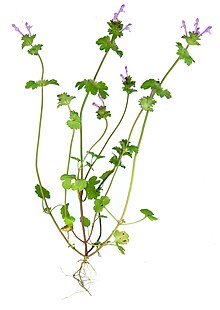| Lamium amplexicaule | |
|---|---|

| |
| Scientific classification | |
| Kingdom: | Plantae |
| Clade: | Tracheophytes |
| Clade: | Angiosperms |
| Clade: | Eudicots |
| Clade: | Asterids |
| Order: | Lamiales |
| Family: | Lamiaceae |
| Genus: | Lamium |
| Species: | L. amplexicaule
|
| Binomial name | |
| Lamium amplexicaule | |
Lamium amplexicaule, commonly known as common henbit, or greater henbit, is a species of Lamium native to Europe, Asia and northern Africa.
It is a low-growing annual plant growing to 10–25 cm (3.9–9.8 in) tall, with soft, finely hairy stems. The leaves are opposite, rounded, 2–3 cm (0.79–1.18 in) diameter, with a lobed margin. The flowers are pink to purple, 1.5–2 cm (0.59–0.79 in) long. The specific name refers to the amplexicaul leaves (leaves grasping the stem).
Description[edit]
Henbit is an annual herb with a sprawling habit and short, erect, squarish, lightly hairy stems. It grows to a height of about 40 cm (16 in).[1] The leaves are in opposite pairs, often with long internodes. The lower leaves are stalked and the upper ones stalkless, often fused, and clasping the stems. The blades are hairy and kidney-shaped, with rounded teeth. The flowers are relatively large and form a few-flowered terminal spike with axillary whorls. The calyx is regular with five lobes and closes up after flowering. The corolla is purplish-red, fused into a tube 15 to 20 mm (1⁄2 to 3⁄4 in) long. The upper lip is convex, 3 to 5 mm (1⁄8 to 3⁄16 in) long and the lower lip has three lobes, two small side ones and a larger central one 1.5 to 2.5 mm (1⁄16 to 1⁄8 in) long. There are four stamens, two long and two short. The gynoecium has two fused carpels and the fruit is a four-chambered schizocarp.[2]
This plant flowers very early in the spring even in northern areas, and for most of the winter and the early spring in warmer locations such as the Mediterranean region. At times of year when there are not many pollinating insects, the flowers self-pollinate.
Distribution and habitat[edit]



Henbit dead-nettle is probably native to the Mediterranean region but has since spread around the world. It is found growing in open areas, gardens, fields and meadows.[2][3] It propagates freely by seed, where it becomes a key part of a meadow ecosystem, Sometimes entire fields will be reddish-purple with its flowers before spring ploughing. Where common, it is an important nectar and pollen plant for bees, especially honeybees, where it helps start the spring build up.
It is widely naturalised in eastern North America and elsewhere. However, its attractive appearance, edibility, and readiness to grow in many climates often mean it is permitted to grow when other weeds are not. This plant, though common, is not regarded as a threat to local ecosystems. It plays an arguably beneficial role in its environment by providing nectar to pollinators and providing forage for animals. The seed is also eaten by many species of birds.[4]
Uses[edit]
The young leaves and shoots can be eaten raw or cooked,[1][3] as can the stems and flowers. Henbit has a slightly sweet and peppery flavor, similar to celery.
References[edit]
- ^ a b Elias, Thomas S.; Dykeman, Peter A. (2009) [1982]. Edible Wild Plants: A North American Field Guide to Over 200 Natural Foods. New York: Sterling. p. 116. ISBN 978-1-4027-6715-9. OCLC 244766414.
- ^ a b "Henbit dead-nettle: Lamium amplexicaule". NatureGate. Retrieved 2013-12-15.
- ^ a b "Henbit, Lamium amplexicaule". Wisconsin Horticulture. Archived from the original on 2024-04-22. Retrieved 2024-04-22.
- ^ "A Little Bit of Henbit". Southern meadows. 2015-02-06.
External links[edit]
- Jepson Manual Treatment
- USDA Plants Profile
- Lamium amplexicaule in the CalPhotos photo database, University of California, Berkeley